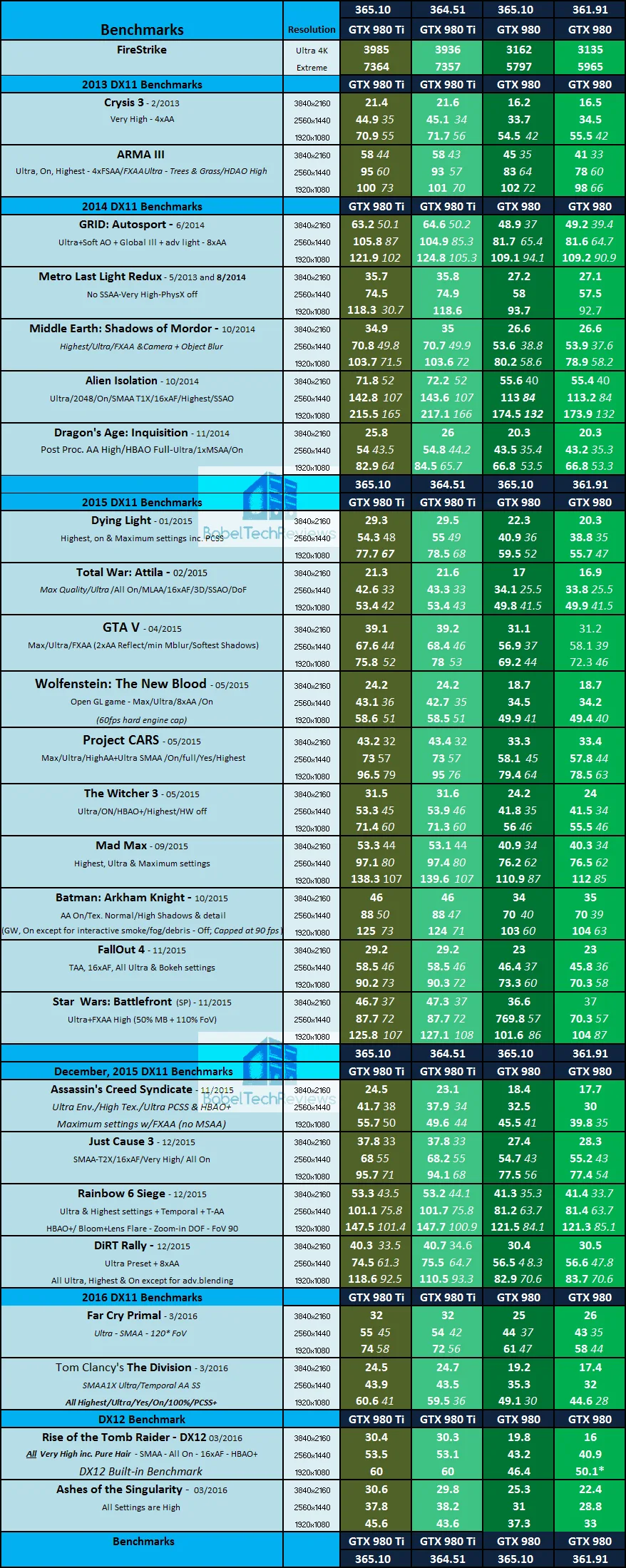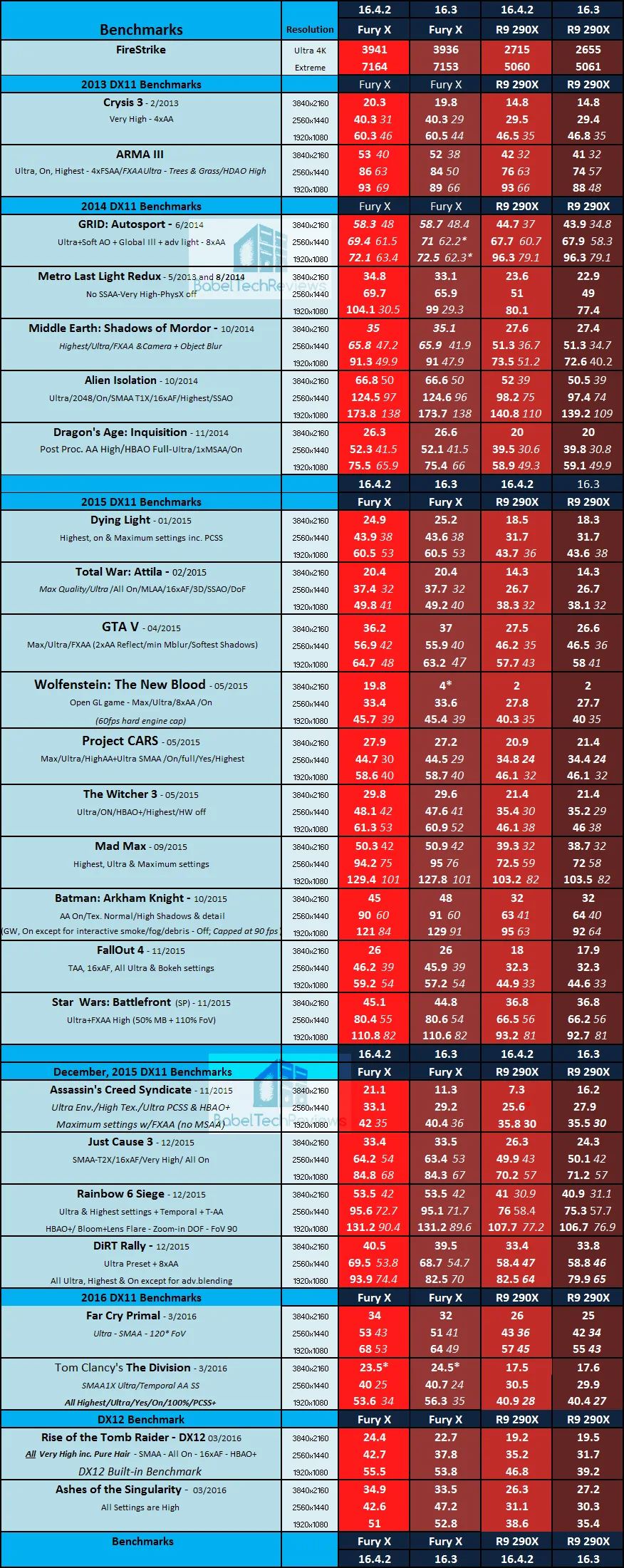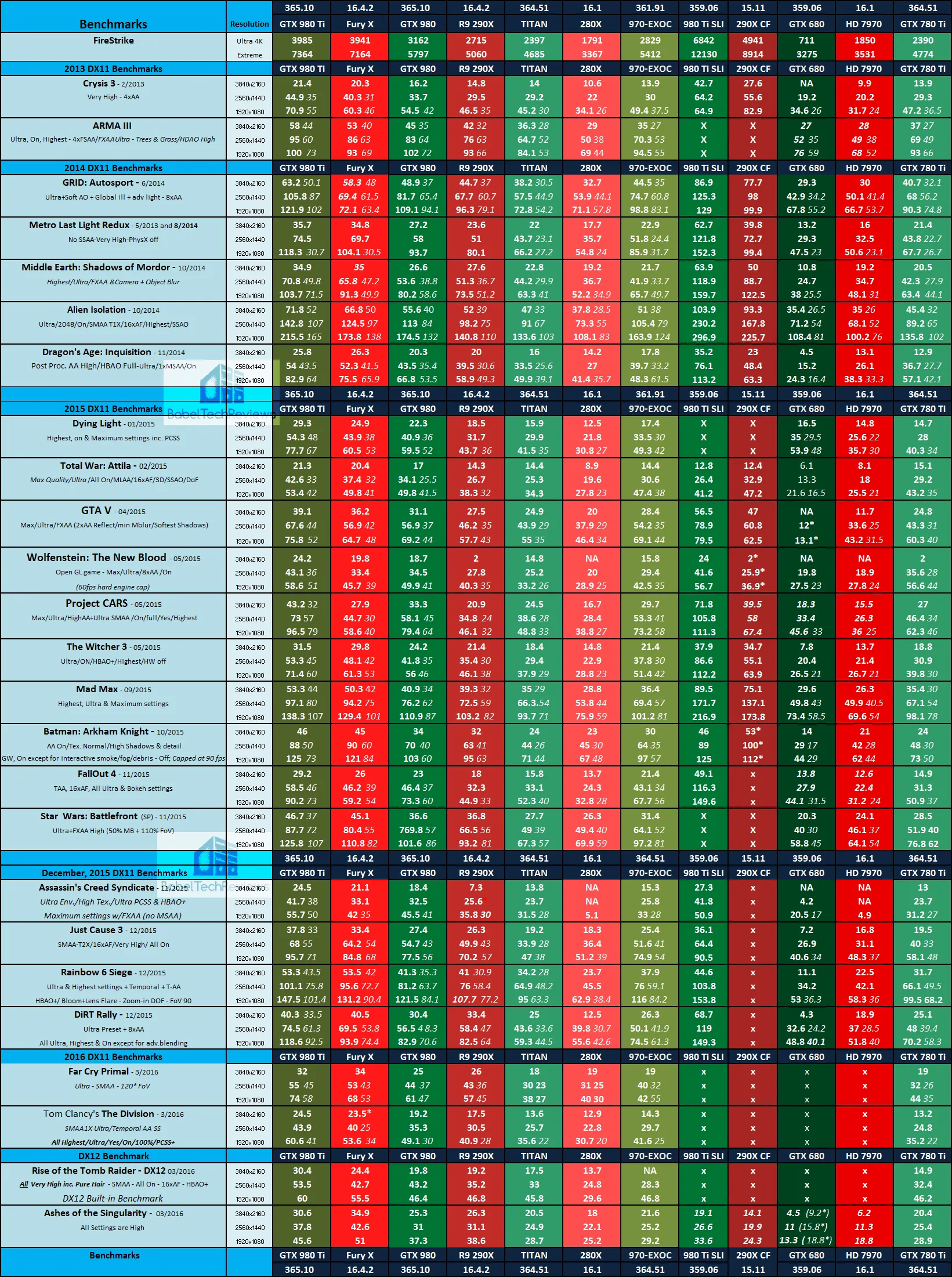Today’s driver performance analysis charts the performance of 25 games using the GTX 980 Ti with the very latest GeForce WHQL driver 365.10, and we are also focusing on the competing Fury X and AMD’s Crimson Software version 16.4.2.
 We are also testing the GTX 980 versus the R9 290X with these new drivers from both AMD and Nvidia featuring our newest 2016 games including Far Cry Primal, Tom’s Clancy’s The Division, as well as Ashes of the Singularity and Rise of the Tomb Raider using DX12. We will compare the performance of 25 modern games, including the very latest, at 1920×1080, 2560×1440, and at 3840×2160 resolutions for our recently revamped benching suite.
We are also testing the GTX 980 versus the R9 290X with these new drivers from both AMD and Nvidia featuring our newest 2016 games including Far Cry Primal, Tom’s Clancy’s The Division, as well as Ashes of the Singularity and Rise of the Tomb Raider using DX12. We will compare the performance of 25 modern games, including the very latest, at 1920×1080, 2560×1440, and at 3840×2160 resolutions for our recently revamped benching suite.
BTR’s The Big Picture, once reserved for video card reviews is now included in every driver performance analysis. We want to document the performance changes of the GeForce WHQL 365.10 driver since we tested Nvidia’s 364.51 WHQL driver set on Windows 10, as well as taking a closer look at the performance changes of this latest driver with our newest target games. In like manner, we will chart the performance changes of the Crimson Software driver 16.4.2 since 16.3. This comparison was completely up to date earlier this week until Hotfix 15.5.1 was released this Tuesday, including the testing of all games with their very latest patches.
It is clear that Nvidia is focusing on VR and especially on the very latest games with their newest WHQL driver GeForce 365.10. AMD also appears to be focused on these same games with Crimson Software 16.4.1, so this will be an interesting evaluation.
Our testing platform is Windows 10 Home 64-bit, using an Intel Core i7-4790K at 4.00GHz which turbos to 4.4GHz for all cores, an ASUS Z97E motherboard, and 16GB of Kingston “Beast” HyperX DDR3 at 2133MHz. The settings and hardware are identical except for the drivers being tested.
At R9 280X or at GTX 970 performance level and above, we test at higher settings and resolutions generally than we test midrange and lower-end cards. All of our games are now tested at three resolutions, and we use DX11 or DX12 when available with a very strong emphasis on the latest demanding 2015-2016 PC games.
Let’s get right to the test configuration, to the driver release notes, and then to the results.
Test Configuration – Hardware
- Intel Core i7-4790K (reference 4.0GHz, HyperThreading and Turbo boost is on to 4.4GHz; DX11 CPU graphics), supplied by Intel.
- ASUS Z97-E motherboard (Intel Z97 chipset, latest BIOS, PCIe 3.0 specification, CrossFire/SLI 8x+8x)
- Kingston 16 GB HyperX Beast DDR3 RAM (2×8 GB, dual-channel at 2133MHz, supplied by Kingston)
- GeForce GTX 980 Ti, 6GB reference clocks, supplied by Nvidia
- GeForce GTX 980, 4GB, reference clocks, supplied by Nvidia
- PowerColor R9 Fury X 4GB, stock clocks.
- VisionTek R9 290X 4GB at stock Uber clocks but with the fan allowed to spin up to 100% to prevent throttling.
- Two 2TB Toshiba 7200 rpm HDDs
- EVGA 1000G 1000W power supply unit
- Cooler Master 2.0 Seidon, supplied by Cooler Master
- Onboard Realtek Audio
- Genius SP-D150 speakers, supplied by Genius
- Thermaltake Overseer RX-I full tower case, supplied by Thermaltake
- ASUS 12X Blu-ray writer
- Monoprice Crystal Pro 4K
Test Configuration – Software
- Nvidia’s GeForce 364.51 and 365.10 drivers were used to benchmark the GTX 980 Ti. WHQL 365.10 and 361.91 were used for the GTX 980. High Quality, prefer maximum performance, single display. Nvidia divers used in the Big Picture are noted on the chart.
- The AMD Crimson Software 16.3 beta drivers and hotfix 16.4.1 were used for benching the Fury X and for the 290X. AMD divers used in the Big Picture are noted on the chart. Global settings are noted below after benchmark suite.
- VSync is off in the control panel.
- AA enabled as noted in games; all in-game settings are specified with 16xAF always applied
- All results show average frame rates including minimum frame rates shown in italics on the chart next to the averages in smaller font.
- Highest quality sound (stereo) used in all games.
- Windows 10 64-bit Home edition, all DX11 titles were run under DX11 render paths. Our only DX12 title is run under the DX12 render path. Latest DirectX
- All games are patched to their latest versions at time of publication.
- EVGA’s PrecisionX, latest version for Nvidia cards.
The 25 PC Game benchmark suite & 1 synthetic test
- Synthetic
- Firestrike – Basic & Extreme
-
DX11* Games
- Crysis 3
- Metro: Last Light Redux (2014)
- Sniper Elite 3
- GRID: Autosport
- Middle Earth: Shadows of Mordor
- Alien Isolation
- Dragon’s Age: Inquisition
- Dying Light
- Total War: Attila
- *Wolfenstein: The Old Blood (*OpenGL game)
- Grand Theft Auto V
- ProjectCARS
- the Witcher 3
- Batman: Arkham Origins
- Mad Max
- Fallout 4
- Star Wars Battlefront
- Assassin’s Creed Syndicate
- Just Cause 3
- Rainbow Six Siege
- DiRT Rally
- Far Cry Primal
- Tom Clancy’s The Division
- DX12 Games
- Ashes of the Singularity
- Rise of the Tomb Raider
Here are the settings that we always use in AMD’s Crimson Control Center for our default benching. They are identical settings to what we used in the older Catalyst Control Center. The new Power Efficiency Toggle which was made available for the Fury X and some 300 series cards by Crimson Software 16.3, is left off in our benching.
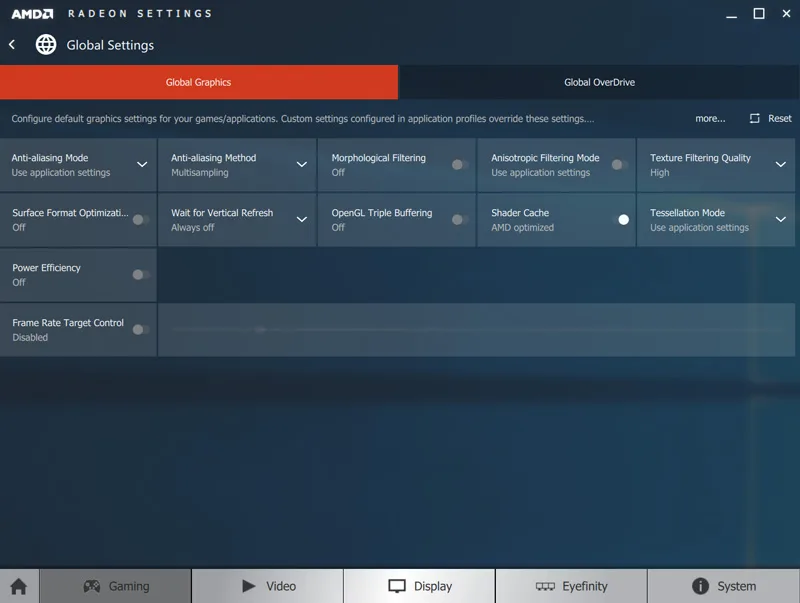
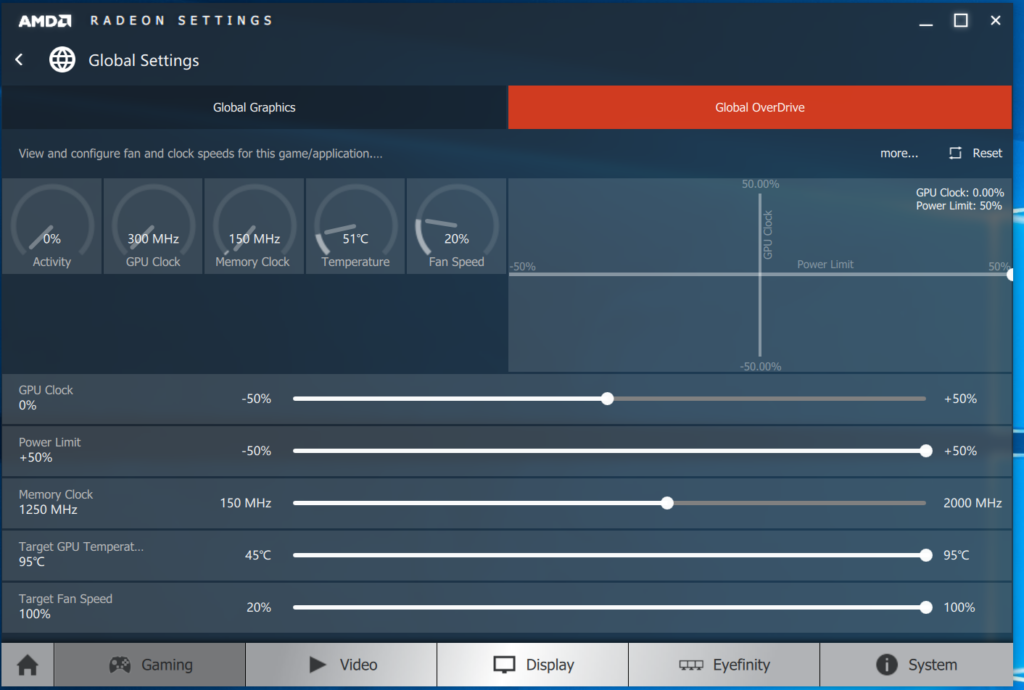 Notice that we bench our 290X with the fan set to allow it to spin up to 100%. It never throttles under our benching conditions.
Notice that we bench our 290X with the fan set to allow it to spin up to 100%. It never throttles under our benching conditions.
Nvidia’s Control Panel settings:

Release Notes Highlights for Crimson Software 16.4.1 Drivers
The release notes and download links for the Crimson Catalyst 16.4.1 beta drivers can be found here for Windows 10. We have benched the Fury X and 290X using this driver for this evaluation.
Radeon Software Crimson Edition 16.4.1 Highlights
Support for:
- Quantum Break™
- Upto 35% faster performance using Quantum Break™ on Radeon™ R9 Fury X than with Radeon™ Software Crimson Edition 16.3.2(1).
- Oculus Rift™
- HTC Vive™
Important Note
Please disconnect the HTC Vive™ headset from the computer before installing the AMD Radeon Crimson Edition 16.4.1 driver. Once the driver installation is complete you may reconnect the HTC Vive™ headset.
Resolved Issues
- Frame rate capping issues experienced in some DirectX®12 applications is resolved.
- Hitman™ may experience flickering when played in DirectX® 11 mode using high game shadow settings.
Known Issues
- A few game titles may fail to launch or crash if the AMD Gaming Evolved overlay is enabled. A temporary workaround is to disable the AMD Gaming Evolved “In Game Overlay”
- Need For Speed™ may experience poor scaling or flickering in AMD Crossfire™ mode. As a work around users can disable the profile through the Radeon™ Settings game manager.
- The Division™ may experience flickering in AMD Crossfire™ mode.
- Power efficiency toggle in Radeon™ Settings is showing up for some unsupported products.
- XCOM2™ users may experience an application crash when using AMD Crossfire™ mode. As a work around please disable AMD Crossfire™ for the games profile in the Radeon™ Settings Gaming tab.
- Some DX9 applications cannot disable AMD Crossfire™ mode through Radeon™ Settings.
- A small subset of AMD Radeon™ R9 380 users may be experiencing slower than expected fan speeds. A work around is to raise your fan speeds through AMD Overdrive in Radeon™ Settings manually to a desired amount.
- HDMI Scaling options may not be available in Radeon™ Settings on some system configurations.
Release Notes Highlights for GeForce 365.10
The release highlights for GeForce 365.10 can be found here together with a download link for Windows 10/8.1/7 64-bit. Below is a short list highlighting the fact that Nvidia’s WHQL driver release schedule is tied to the release of AAA games.
Prior to a new title launching, our driver team is working up until the last minute to ensure every performance tweak and bug fix possible makes it into the Game Ready driver. As a result, you can be sure you’ll have the best day-1 gaming experience for your favorite new titles.
Game Ready
Learn more about how to get the optimal experience for Battleborn, Forza Motorsport 6: APEX Beta, OverwatchBeta, and Paragon Beta.
For the comprehensive release notes, you will need to download the .pdf
Benchmarks & Performance Analysis
GeForce 364.51 versus GeForce 365.10
Here are our results of 25 games and 1 synthetic compared between GeForce 364.51 WHQL drivers, and GeForce 365.10 WHQL drivers using the 980, and the GTX 980 Ti.
Each set of drivers are compared against the other in the adjoining results column.
We can see good performance gains for the GTX 980 Ti with the newest drivers with our target games although generally there were decent performance increases overall. ARMA III is CPU bound at 1920×1080 as the GTX 980 actually got a higher average framerate than the GTX 980 Ti.
Catalyst Crimson Software 16.3 versus 16.4.1
In the chart below, we track the Fury X and the 290X from Crimson Software16.3 to hotfix 16.4.1.
We can see good performance gains for Fury X with 16.4.1 even over 16.3, and even the 290X got some nice performance improvements. There were some issues with being able to change resolutions with GRiD: Autosport with Fury X as the 290X showed improvements with the lower resolution while Fury X didn’t. There was also a lot of flickering with The Division at 4K resolution with Fury X that the 290X did not exhibit. However, Fury X showed improved memory management with Wolfenstein while 290X is barely a slideshow.
AMD vs Nvidia – Fury X vs GTX 980 Ti and 280X & 290X vs. GTX 970 & GTX 980
Of course, we want to directly compare the Fury X versus the GTX 980 Ti and the 290X versus the GTX 980.
Finally, let’s check out our bigger picture next.
The Big Picture
The Big Picture, once reserved solely for our video card reviews, has been recently expanded to feature all of our competing top video cards on recent drivers. We are benching the GTX 980 Ti and the GTX 980 versus the Fury X, the GTX 970 OC versus the R9 290X and even the 280X; and for added information, 290X CrossFire and GTX 980 SLI results. We even include the GTX 680 and the HD 7970 as well as the GTX 780 ti on recent drivers.
This time, “X” means the benchmark was not run, and “NA” means the benchmark could not be run or completed. And an Asterisk (*) means that there are some real issues with the visuals.
Let’s head to our conclusion.
Conclusion:
We would recommend upgrading to the latest GeForce 365.10 drivers as they have brought some improvements to some of the very latest games. There are generally incremental advantages over older drivers, and no large performance-impacting negatives that we have encountered. We recommend always using Nvidia’s latest WHQL driver for Windows 10.
 AMD’s second latest driver Crimson Software 16.4.1 also brings real performance improvements for the Fury X and other AMD cards over earlier drivers, and we would also recommend upgrading to AMD’s latest drivers. The very latest driver was released earlier this week as a hotfix, 16.5.1.
AMD’s second latest driver Crimson Software 16.4.1 also brings real performance improvements for the Fury X and other AMD cards over earlier drivers, and we would also recommend upgrading to AMD’s latest drivers. The very latest driver was released earlier this week as a hotfix, 16.5.1.
GeForce WHQL 365.10 and the latest Crimson Software are generally the best drivers to use for the latest really fun games that we are playing, including Rise of the Tomb Raider, Far Cry Primal, Hitman, and Tom’s Clancy’s The Division.
It appears that both Nvidia and AMD intend to release new drivers with each new major PC game release, and we are looking forward to our next Driver Performance Evaluation. Stay tuned, we are reporting from Austin, Texas, tonight for Nvidia’s big livestream event.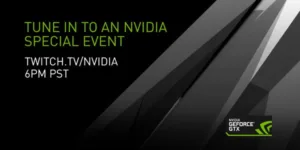
Happy gaming!
